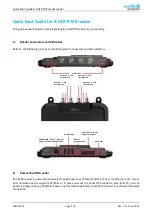
Rockwell Automation Publication 1606-RM100A-EN-P - July 2020
23
Power Supply - 24V, 5 A, 120 W, Single-phase Input Reference Manual
When the power supply provides a sufficient voltage, the buffer module stores
energy in the integrated electrolytic capacitors. When the mains voltage is lost,
the stored energy is released to the DC-bus in a regulated process.
The buffer module can be added in parallel to the load circuit at any given
point and does not require any control wiring.
One buffer module can deliver 20 A additional current and can be added in
parallel to increase the output ampacity or the hold-up time.
Application Notes
All parameters are typical values that are specified at 230V AC, 50 Hz input
voltage, 24V, 5 A output load, 25 °C ambient and after a 5 minutes run-in time
unless otherwise noted.
Peak Current Capability
The unit can deliver peak currents (up to several milliseconds) which are
higher than the specified short-term currents.
This helps to start loads that demand a high current. Solenoids, contactors,
and pneumatic modules often have a steady state coil and a pick-up coil. The
inrush current demand of the pick-up coil is several times higher than the
steady-state current and usually exceeds the nominal output current. The
same situation applies when starting a capacitive load.
The peak current capability also delivers the safe operation of subsequent
circuit breakers of load circuits. The load branches are often individually
protected with circuit breakers or fuses. If there is a short or an overload in one
branch circuit, the fuse or circuit breaker need a certain amount of overcurrent
to open in a timely manner. This avoids voltage loss in adjacent circuits.
The extra current (peak current) is supplied by the power converter and the
built-in large sized output capacitors of the power supply. The capacitors get
discharged during such an event, which causes a voltage dip on the output. The
following three examples show typical voltage dips for resistive loads
:
Figure 35 - 10 A Peak Current for 50 ms, Typ
(2x the Nominal Current)
Figure 36 - 25 A Peak Current for 5 ms, Typ
(5x the Nominal Current)
Figure 37 - 15 A Peak Current for 12 ms, Typ
(3x the Nominal Current)










































